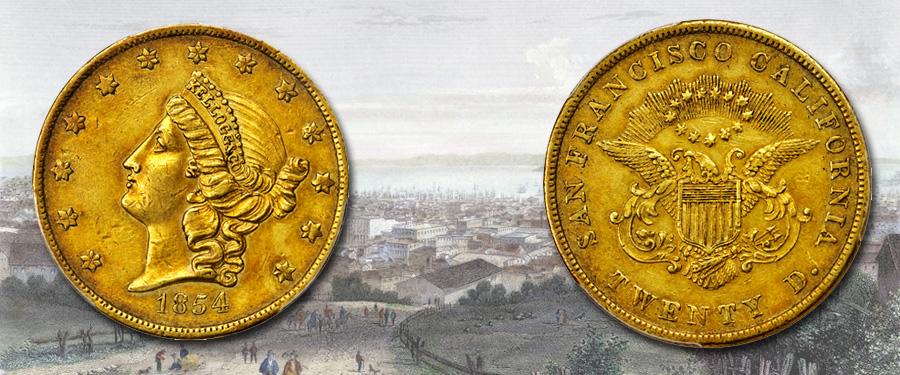
Economic
growth catalyzed by the California Gold Rush in the early 1850s spurred demand
for circulating coinage throughout the West.
Unimpressed by the production of private minting firms, the citizens of
California proposed that the state establish an assay office in order to
regulate the gold pouring out of mines and into the economy. While the
regulation and ingots provided by this State Assay Office were crucial, circulating
coinage still remained sparse and demands were soon made for further
assistance.
Delegations
from Georgia, North Carolina and Louisiana opposed the establishment of a mint
in California, citing competition to their respective branch mints. In an act
of compromise, a bill providing for a United Stated Assay Office to be
established in San Francisco was passed on September 30, 1850, with the
understanding that a branch mint would be appropriated for California at the
next session of Congress. Though initially only authorized to issue
denominations of $50 to $10,000, demand for more practical denominations led to
the striking of $10 and $20 coins through a contract with the firm Moffat &
Co. While the U.S. Assay Office provided
a much-needed service to the region, a dedicated branch mint was still
necessary to sustain and support a flourishing economy. After much imploring,
lobbying and deliberation, a bill to establish a San Francisco branch mint
became law on July 3, 1952.
Having
bought out John Moffat’s interest in his eponymous firm, the remaining partners
Curtis and Perry also bought out the contract to furnish the building and the
equipment for the new mint. In preparation for the arrival of the Mint,
Treasury Secretary Corwin suggested to Director of the Mint Snowden that the
U.S. Assay Office should close on November 1, 1853, though operations did not
officially cease until just over a month later.
It
was during this interval between the closing of the assay office on December
14, 1853, and the opening of the San Francisco Mint on April 15, 1854, that
circulating coinage once again fell to critical levels. The regulation provided
by the Assay Office had discredited and exercised virtually all private
minters, and even the issues that were considered legitimate faced melting and
exportation. In recognition of this,
former lawyer John G. Kellogg and assayer G.F. Richter opened a gold melting
and assaying office in mid-December 1853, having receiving the endorsements of
U.S. Assay operators Humbert, Curtis and Perry. A collective of regional banks, including such
establishments as James King of William and Wells Fargo & Co., wrote to the
newly established Kellogg & Richter on January 14, 1854, pleading for them
to “supply the vacuum until the Mint shall go into operation, and remove the
chance of financial embarrassment from the cause, by issuing your own private
coin.” In a letter dated January 31, 1854, Kellogg replied affirmatively,
stating their private coins would be issued within ten days. On February 9 the
first Kellogg $20s were issued.
With
motifs largely similar to the Longacre design used on the Federal Liberty
double eagle, Kellogg & Richter claimed an output of $20,000 worth of the
coins per day. This proved invaluable for sustaining the economy through the
formative era of the San Francisco Mint. Production of the Kellogg & Co.
$20s would continue through 1855 with about $20 million worth of the coins
being struck in total.
The handsome
1854 Kellogg $20 to be offered in our Rarities Night Session at the Whitman
Coin & Collectibles Expo this November is warm honey-gold with bronze hues in
the protected areas. Uniformly rendered and bold throughout, there is none of
the obverse peripheral softness that often plagues examples of this issue. Traces
of mint luster are seen within the most intricate central elements on each
side.
To
consign your rarities to our Official Auction of the Whitman Coin &
Collectibles Baltimore Expo, please contact our offices today at 1-800-458-4646
to speak with a Consignment Director and see what Stack’s Bowers Galleries can
do for you.





